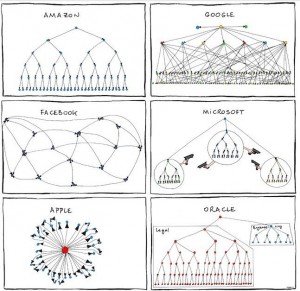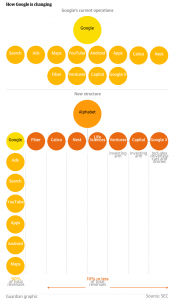What Alphabet Means
Many years ago, a satirical organizational chart was circulated around the Internet. Though the graphic was meant to be humorous, it is surprisingly insightful to some extent.
If we examine Google’s structure in particular, it loosely resembles the hierarchal organizational structure found in many companies. However, because of the vast number of uncentralized projects that Google is known for, the structure becomes rather convoluted. Projects are dropped and picked up at random. Therefore, the organizational structure really resembles that of a “ball of yarn.”
Recently, however, Google has made tremendous endeavors to completely reorganize the structure of its company with the introduction of …
Alphabet
Essentially, there will be a shift in the hierarchy so that Google no longer serves as the top of the command structure. Instead, Google will become a company until Alphabet along with other corporations such as Google X, Google Ventures, Calico, Fiber, etc. The shift in structure is loosely diagrammed below :
Google will remain as the main source of revenue for the company, but new room will be made for the other companies until Alphabet to flourish independently. Larry Page and Sergey Brin, the co-founders of Google, will be handing off control of the Google enterprise to Sundar Pichai.
So, how does this restructuring affect the company, in terms of networks? Previously, Google served as the head of command for a lot of the smaller ventures under it. However, as time passed and the corporation grew, each of the branches grew more separate. In turn, the old organizational structure became burdened and outdated. With the new rearrangement under the umbrella of Alphabet, Google’s other ventures will be allowed more room to grow.
Page claims that “Fundamentally, we believe this allows us more management scale, as we can run things independently that aren’t very related.”
In relation to the first “ball of yarn” organizational chart, this shift will allow Google to prove that its side ventures are not just impulsive acts of flippancy. Rather, the new structure will allow the different brands of management to really flesh out the various companies. Another point to note is that the new hierarchy will allow more room for strong leadership. The introduction of independence naturally breeds room for new CEO’s as more individuals step up to the plate.
It’s interesting to point out that Google deems the process as “slimming down,” even though a new node is being created on the graph. This is because the original Google itself is being slimmed down. Though it still has 90% of all operations, the Google portion of Alphabet is still smaller than the previous Google, which headed all operations of the corporation. The rest of the companies are also slimmer in comparison to the original Google.
An added benefit is that “Alphabet allows Google to treat these newer companies as startups and invest heavily without penalizing the core business,” said Neil Doshi, an analyst at Mizuho Securities USA Inc.
Overall, the introduction of Alphabet really does effectively introduce a new organizational structure that will benefit Google from a networks point of view. Each branch of Alphabet will be more directed and process streamlined. Google is updating its organizational structure (just as it updated its logo) to mirror the times.
Sources


